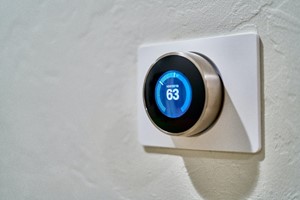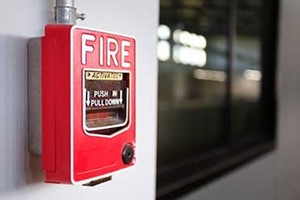Smart buildings signify a remarkable evolution in the construction and management of real estate. These structures harness cutting-edge technologies to optimize energy efficiency, enhance occupant comfort, and streamline facility operations. ‘Smart’ buildings are distinguished by their ability to collect and analyze data from a range of in-built sensors and systems, enabling real-time insights and intelligent decision-making. As these structures continue to proliferate, they unlock new possibilities for enhancing fire safety. This evolution underscores the necessity for innovative fire safety solutions that seamlessly integrate into the fabric of smart environments.
The integration of fire safety measures in smart buildings is crucial due to the complexities introduced by data integration, connectivity, and automation. Beyond regulatory requirements, ensuring the safety of occupants and protecting assets is a fundamental necessity in these high-tech structures. The convergence of IoT and fire safety proves promising in this interconnected landscape, providing improved monitoring, quicker response times, and more efficient management of fire-related risks.
The Intersection of Smart Building And Fire Safety
The integration of smart building technologies with fire safety represents a significant advancement in modern infrastructure management. Smart buildings, equipped with interconnected devices and sensors, leverage the power of the Internet of Things (IoT) to optimize operations and enhance the overall living or working experience. Within this framework, fire safety emerges as a crucial aspect, given the potential risks and consequences associated with fire incidents in these highly integrated environments.
IoT, in the context of smart buildings, involves deploying sensors, actuators, and other connected devices throughout the structure. These devices collect and transmit data, enabling real-time monitoring and control of various building systems, including lighting, HVAC, security, and fire safety. The data generated by these sensors provide valuable insights that empower building managers and occupants to make informed decisions, improve efficiency, and enhance safety protocols.
The profound impact of IoT on fire safety lies in its ability to enhance detection and response mechanisms. Through smart smoke detectors and thermal imaging cameras, IoT enables accurate and timely identification of smoke or heat anomalies. These devices communicate instantly with building management systems and emergency responders, reducing response times and minimizing potential damage. Real-time monitoring of fire safety equipment ensures optimal functionality, increasing reliability and readiness in preventing harm to occupants and property.
The integration of IoT into fire safety systems provides several advantages. It improves situational awareness by furnishing precise information on fire location and severity, enhancing evacuation and firefighting efficiency. Additionally, IoT enables predictive analytics for early identification of potential fire risks, and remote sensing allows immediate off-site response. This proactive and responsive approach optimizes smart building management, ensuring the safety of lives and property in our interconnected world.
IoT Solutions for Enhanced, Smart Fire Safety
In modern smart buildings, IoT solutions have revolutionized fire safety by offering a multifaceted approach to detection, monitoring, and response.
- Advanced fire detection
- Smart Smoke Detectors: These innovative devices go beyond traditional smoke detectors. They can differentiate between harmless smoke and a real fire, reducing false alarms. Some even provide early warning by detecting subtle changes in air quality.
- Thermal Imaging Cameras: These cameras use infrared technology to visualize heat patterns. In a fire safety context, they can quickly identify hotspots or unusual temperature increases, even in low visibility conditions, aiding early fire detection.
- Real-time monitoring and alerts
- Remote Sensing and Control: IoT systems allow for remote monitoring of fire safety equipment. Building managers can receive real-time updates on the status of fire alarms, suppression systems, and emergency lighting, enabling swift responses when needed.
- Predictive Analytics: By analyzing data from various sensors, predictive analytics can identify potential fire risks before they escalate. This proactive approach can help prevent fire incidents and optimize safety protocols.
- Evacuation and emergency response
- Smart Signage and Wayfinding: In the event of a fire, smart signage and wayfinding systems can provide occupants with clear and dynamic evacuation routes. These systems can adapt to changing conditions and guide individuals to the safest exits.
- Communication Systems: Effective communication during emergencies is crucial. IoT enables interconnected communication systems that can relay emergency messages, instructions, and updates to building occupants, emergency responders, and management, ensuring coordinated and efficient responses.
IoT solutions not only improve fire safety efficiency but also reduce response times, minimizing potential property damage and harm to occupants. The interconnected nature of these systems offers a comprehensive and adaptive approach to fire safety within smart buildings.
Overcoming Challenges and Identifying Opportunities for Smart Fire Protection
Integrating IoT solutions into fire safety systems in smart buildings presents a range of challenges and opportunities that require careful consideration.
- Data Security and Privacy: As IoT devices collect and transmit sensitive data, ensuring security and privacy becomes paramount. Robust encryption and authentication protocols must be in place to protect against potential breaches. Additionally, clear data privacy policies and compliance measures are crucial to safeguard the personal information of building occupants.
- Maintenance and Reliability: Like any technology, IoT-enabled fire safety systems require regular maintenance to ensure ongoing reliability. Neglecting maintenance can result in system failures or false alarms, eroding trust in the system. Building owners and managers should establish maintenance schedules and protocols to guarantee seamless operation.
- Cost Considerations: While IoT solutions offer significant benefits, there are associated costs, including sensor and device purchases, ongoing maintenance, and personnel training. However, it’s important to view these expenses in the context of potential savings in terms of reduced fire damage, improved operational efficiency, and enhanced safety.
By addressing security, maintenance, and cost considerations head-on, organizations can unlock the full potential of IoT for fire safety while mitigating potential risks. This proactive approach ensures that smart buildings become safer and more efficient environments.
Future Trends and Innovations For IoT-Enhanced Fire Safety
The future of fire safety in IoT holds promising advancements and innovations that will further enhance the protection of smart buildings. As IoT technology matures, it will seamlessly integrate with building management systems, enabling a holistic approach to fire safety. This integration empowers building managers to monitor, control, and respond to fire risks in real-time, alongside other building operations. Predictive analytics will also play a significant role, foreseeing potential fire hazards before they escalate.
A growing emphasis on sustainability and energy efficiency will drive IoT-enabled fire safety innovations. New sensor technologies not only detect fires but also assess their environmental impact, facilitating more eco-friendly fire suppression methods. Moreover, these systems will integrate with broader sustainability efforts, optimizing building operations to reduce energy consumption while maintaining fire safety.
The journey towards smarter fire safety in smart buildings is ongoing. Building owners, managers, and technology developers must collaborate to refine and expand IoT solutions. The ultimate goal is to create a safer, more efficient, and sustainable built environment for all. By harnessing the power of IoT, we can not only detect and respond to fire incidents but also proactively prevent them. These trends and innovations will shape the future of fire safety in the evolving landscape of smart buildings, maintaining the highest standards of safety and efficiency.
Edited by Yehya Aoun












